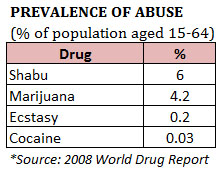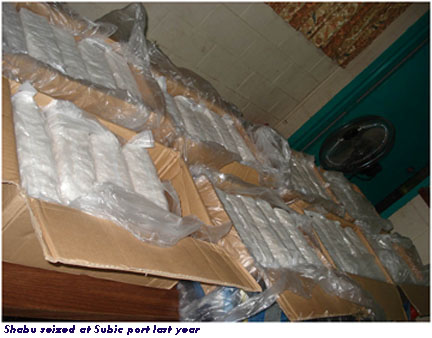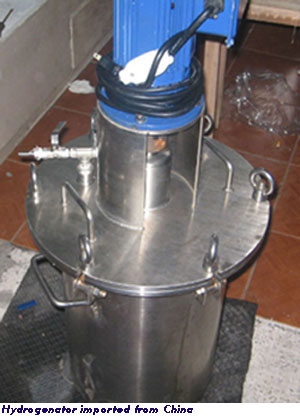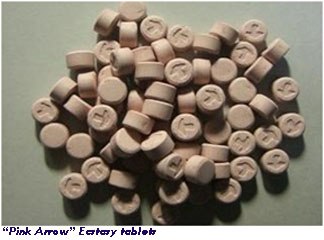By YVONNE CHUA, IBARRA MATEO, LUZ RIMBAN and ELLEN TORDESILLAS THE trade in crystal methamphetamine hydrochloride or “shabu” in the Philippines has grown into a P1 billion-a-day industry, but the drug has now become more expensive, making it “the poor man’s cocaine no more,” antinarcotics officials and international drug reports said.
THE trade in crystal methamphetamine hydrochloride or “shabu” in the Philippines has grown into a P1 billion-a-day industry, but the drug has now become more expensive, making it “the poor man’s cocaine no more,” antinarcotics officials and international drug reports said.
The price of shabu has doubled to between P8,000 and P10,000 per gram since law enforcers dismantled several “mega-laboratories” in 2006 and 2007.
But government successes in curbing shabu production have been offset by another problem: Users are now turning to the amphetamine-type stimulant Ecstasy, which sells for P750 to P800 per tablet, and cocaine, which sells for P2,500 per gram, the kinds of drugs that were seized from “Alabang Boys” Richard Brodett, Jorge Joseph and Joseph Ramirez Tecson by agents of the Philippine Drug Enforcement Agency in a drug-bust operation last September.
The 2008 World Drug Report of the United Nations Office on Drugs and Crime (UNODC) said the Philippines “continues to have the world’s highest estimated annual methamphetamine prevalence rate” at 6 percent of the population. Officials from PDEA and the Philippine National Police said in separate interviews that nearly 200 kilos of shabu are sold every day at a wholesale price of P5 million a kilo or P1 billion a day.
 The UNODC report said that methamphetamine use in the Philippines has actually declined. “Accomplished ang mission namin. Walang gumagalaw. May psychological warfare—active and passive (We have accomplished our mission. The syndicates are immobile. There is an ongoing psychological warfare, both active and passive),” PDEA Director General Dionisio Santiago said of the shabu syndicates.
The UNODC report said that methamphetamine use in the Philippines has actually declined. “Accomplished ang mission namin. Walang gumagalaw. May psychological warfare—active and passive (We have accomplished our mission. The syndicates are immobile. There is an ongoing psychological warfare, both active and passive),” PDEA Director General Dionisio Santiago said of the shabu syndicates.
But with the antinarcotics crackdown over the past years making shabu more scarce and its price steeper, users are now turning to cheaper alternatives and producers shifting to other modes of production.
Antinarcotics officials from PDEA and the PNP reported an increase in the use of Ecstasy or methylenedioxy-methamphetamine (MDMA), a drug favored by the rich now trickling down to the middle class. The 2008 World Drug Report has also noted a rising level of cocaine consumption in the Philippines.
Locally grown marijuana, however, remains the “alternative drug of choice” for shabu users whenever prices of synthetic drugs escalate, according to PDEA. It is also known as the “starter drug” for teenagers.
Demographic data from drug rehabilitation centers nationwide in 2007 indicate poly-drug use among patients, almost one-third of whom were high school students.
The PDEA reported confiscating a veritable spread of drugs from the “Alabang Boys”: shabu, cocaine, Ecstasy, marijuana as well as diazepam or Valium.
Change of tactics
In 2006 and 2007, law enforcement agencies raided and dismantled a dozen clandestine “mega-laboratories” that produced shabu in industrial quantities of 1,000 kilos or more in one cycle.
Law enforcers also arrested several big-time lab operators, among them Chinese nationals who did not speak a word of English or Filipino and who turned out to be the shabu chemists. The chemists took care of “cooking” the shabu and were “embedded” in these labs.
These days, shabu is produced in “large-scale laboratories” that churn out just one-tenth or 100 kilos per production cycle, as well as smaller ones that are easier to dismantle. These labs have also moved to rural and “remote rural areas” in Luzon and Visayas to escape detection. All six major raids on shabu labs last year were outside Metro Manila. They were in La Union, Pampanga, Masbate and Bicol.
The chemists, meanwhile, no longer stay in the labs but just come to the Philippines as tourists, staying only for a week to “cook” the shabu and leaving as soon as production ends and the syndicate has gotten its share—usually one-fourth of the output—in cash, a PNP official said.
 Law enforcers said the chemists are essential to the operation since the Chinese refuse to “transfer” this skill to Filipinos. The Philippine labs also acquire the hydrogenator, a cylindrical equipment used in shabu manufacturing, from the Chinese.
Law enforcers said the chemists are essential to the operation since the Chinese refuse to “transfer” this skill to Filipinos. The Philippine labs also acquire the hydrogenator, a cylindrical equipment used in shabu manufacturing, from the Chinese.
What China leaves to its Philippine counterpart nowadays is the importation of the precursor materials, particularly ephedrine, a basic component in cold tablets that is sourced from India and China. India is said to produce better-quality ephedrine. A hundred kilos of ephedrine can yield 70 kilos of shabu.
The new arrangement makes it more difficult for antinarcotics operatives to detect the labs. “You have to recruit a member of the syndicate to know the location of the lab and the production date,” the PNP official said. “You need a deep penetration agent.”
The drop in local shabu production has also caused a rise in shabu importation from China, PDEA and PNP officials said. From Yunnan province in China, the shabu travels to the Guangxi, Guangdong and Fujian provinces and Hong Kong before ending up in the Philippines.
Shabu arrives at different ports around the country, packed in a variety of containers less likely to be checked, including large giant ornamental jars sold in furniture and ornamental shops in malls, or even inside expensive imported cars.
One source said the new strategy of syndicates is to shun the “traditional ports” in Cavite, Navotas, and Dinggalan in Aurora, preferring instead the less prying eyes in private ports in Zamboanga and Jolo. Using speed boats, illegal drugs are distributed to various destinations or abroad.
Part of the shabu shipped to and produced in the Philippines makes its way to South Korea, Malaysia, Brunei, Taiwan, Japan, Australia, New Zealand, the U.S. (including Guam) and Canada, according to the 2008 UN World Drug Report.
Ecstasy becomes popular
Since the late 1980s, Ecstasy has been popular among showbiz denizens, the rich, and young expatriates in the Philippines. The UN report said Ecstasy users make up 0.2 percent of the population aged 15 to 64.
Antinarcotics agents have said that drugs like Ecstasy are distributed to users at local high-end bars and restaurants, and during concerts. “We are watching (the) international concerts. Illegal drugs are present in these events,” a source said. The source said they have identified these international performers who “carry Ecstasy from Europe.”
Ecstasy is imported, chiefly from the U.S and the Netherlands, said the operatives. But they cited intelligence reports that the drug is now being locally produced in minute quantities on an experimental basis, but of poor quality.
Ecstasy from the Netherlands, on the other hand, is sourced from contacts in Thailand and Malaysia, said PDEA and PNP officials.
One law enforcer said some Ecstasy pills that come from the United States are stuffed into DVD and VCD shipments, the cases lined with carbon paper to prevent detection by X-ray machines. These parcels are then mailed to the Philippines, with “many of them” successfully reaching their local destinations, he said.
 Ecstasy is also known by the following street names or slang: Adam, E, Roll, X, XTC, Dolphin, Cream Honda, Clover, Twin heart, Red hook, Pink dolphin, Blue mushroom, Playboy, Mickey mouse, Pink arrow.
Ecstasy is also known by the following street names or slang: Adam, E, Roll, X, XTC, Dolphin, Cream Honda, Clover, Twin heart, Red hook, Pink dolphin, Blue mushroom, Playboy, Mickey mouse, Pink arrow.
Ecstasy has been called the “hug drug” because users like being touched. Medical researchers have observed that users said they “experience feelings of closeness with others and a desire to touch others.”
“Recently, we found out that different brands have different effects. Some brands heighten sexual desire while some have the effect of giving one a ‘high’ for days,” one source said.
Pharmacologically considered as a stimulant, Ecstasy and its variants enhance mood and increase energy level, “producing intensely pleasurable effects” even allowing users to dance for hours. Once its effects wane, users descend into depression and anxiety, and have sleep disorders.
Others effects include uncontrollable teeth clenching, disappearance of inhibitions, blurred vision, increase in heart rate and blood pressure, and either chills or sweating. Seizures are a possibility.
“The stimulant effects of the drug enable users to dance for extended periods, which when combined with the hot crowded conditions usually found at raves, can lead to severe dehydration and hyperthermia or dramatic increases in body temperature. This can lead to muscle breakdown and kidney, liver and cardiovascular failure. Cardiovascular failure has been reported in some of the Ecstasy-related fatalities,” one medical pamphlet said.
The veterinary anesthetic ketamine has also emerged as a “party drug” among some bar habitués. A horse tranquilizer, it is popularly known as “kets” or “ketabu” and induces psychedelic or hallucinogenic states. A number of Ecstasy pushers also deal in ketamine, said anti-drug officials.
A U.S. State Department report said ketamine is being converted from its legal liquid form to the illicit crystal form in the Philippines and exported to other countries in the region.
Pinay ‘drug mules
Cocaine, produced from the coca leaf grown in South America, has not gained much following in the Philippines. More so with heroin, which is produced chiefly in Afghanistan and Myanmar.
But law enforcers said the country has become a transshipment point for heroin and cocaine as a growing number of Filipinas in their twenties and thirties have been turned into “drug mules” by international syndicates. Also last year, counternarcotics agencies were alerted to cocaine smuggling through a port in northern Luzon.
Cocaine and heroin trafficking in Southeast Asia is handled chiefly by West Africans based in Thailand and Malaysia, in particular Nigerians, they said. Legitimate recruitment agencies hire Filipinas for “jobs” in these neighboring countries, with some ending up as girlfriends of the traffickers.
The powder-form drugs are concealed in false bottoms of carry-on luggage, packs of feminine sanitary towels or candy boxes that get past airport X-ray machines. They are flown into the Philippines and turned over to another Filipina. The latter then flies to another country, including China, usually on a Philippine airline, and hands the shipment over to a member of the syndicate.
About one to 1.5 kilos of cocaine or heroin is transported per voyage, for which the “drug mule” is paid $1,500 to $3,000.
Filipino “drug mules” have been arrested in China and Hawaii airports for heroin possession.
A PDEA official said the canine squad has limitations in detecting illegal drugs at the country’s ports. “A dog that is used to sniffing two grams of drugs may get confused when exposed to a kilo or a ton,” he said.
The dog also becomes ineffective when it is tired, he said.
Mechanics manning X-ray machines at the country’s port fare no better than the dogs. Most are untrained in drug detection and have admitted that they cannot tell an illegal drug even if they come across one, the official said.
The country’s ports also have a different priority. “They are more concerned with explosives than drugs,” he said.